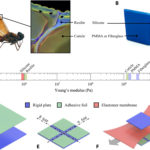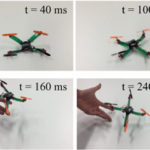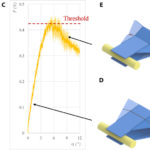Paper, Bioinspired dual-stiffness origami
Origami manufacturing has led to considerable advances in the field of foldable structures with innovative applications in robotics, aerospace, and metamaterials. However, existing origami are either load-bearing structures that are prone to tear and fail if overloaded or resilient soft structures with limited load capability. In this manuscript, we describe an origami structure that displays both high load bearing and high resilience characteristics. The structure, which is inspired by insect wings, consists of a prestretched elastomeric membrane, akin to the soft resilin joints of insect wings, sandwiched between rigid tiles, akin to the rigid cuticles of insect wings. The dual-stiffness properties of the proposed structure are validated by using the origami as an element of a quadcopter frame that can withstand aerodynamic forces within its flight envelope but softens during collisions to avoid permanent damage. In addition, we demonstrate an origami gripper that can be used for rigid grasping but softens to avoid overloading of the manipulated objects.
Learn about our two Decals!
 Click here to find out more about our Fall Bioinspired Design Decal and our Spring Bioinspired Design in Action Decal – ALL MAJORS are welcome.
Click here to find out more about our Fall Bioinspired Design Decal and our Spring Bioinspired Design in Action Decal – ALL MAJORS are welcome.Berkeley BioDesign Community
 Click here to learn about the BioD: Bio-Inspired Design @ Berkeley student organization or here to signup for more info.
Click here to learn about the BioD: Bio-Inspired Design @ Berkeley student organization or here to signup for more info.Search
Student Login






I imagine that the neurological circuits underlying these processes are governed by both 2d spacing maps with their brains as…
to reduce the impact of car accidents, it may be possible to study the force diverting physics of cockroaches to…
you see this type of head-bobbing stability in many avian creatures related to pigeons like chickens. the head ability to…
not like they taught horses how to run! this is an example of convergent evolution where both sea creatures and…
The brain functions in a similar way with neuronal connections. our brains are able to utilize the multiplicity of connections…